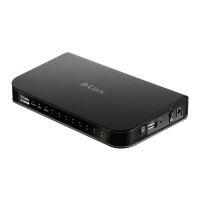D-Link DSR-Series User Manual 32
Section 5 - Connect to the Internet
Connect to the Internet
This router has two WAN ports that can be used to establish a connection to the internet. It is assumed that you
have arranged for internet service with your Internet Service Provider (ISP). Please contact your ISP or network
administrator for the conguration information that will be required to setup the router.
Dynamic IP (DHCP)
Path: Network > Internet > WAN1 Settings
Select Dynamic IP (DHCP) to obtain IP address information automatically from your Internet Service Provider.
Field Description
Enable VLAN Tag Toggle to On/O the VLAN on WAN1.
VLAN ID
This numeric value associated with the VLAN is used to identify trac that is allowed into the WAN1
network. When the trunk mode is enabled, trac which are vlan tagged with this ID is allowed into the
WAN1 network.
Host Name
Enter a host name if required by your ISP.
DNS Server Source
Select either Get Dynamically from ISP or Use These DNS Servers to manually enter DNS servers
Primary DNS Server
If you selected “Use These DNS Servers”, enter the primary DNS server IP address.
Secondary DNS Server
If you selected “Use These DNS Servers”, enter the secondary DNS server IP address.
MAC Address Source
Select Use Default MAC to use the MAC address from the WAN1 port to associate with your modem/ISP,
Clone your PC’s MAC to use the MAC address of the computer you are currently using to associate with
your modem/ISP, or Use this MAC to manually enter a MAC address.
MAC Address If you selected Use this MAC, enter the MAC address you want to associate with your ISP.
MTU Size Select to use the default MTU value (1500) or select Custom to enter your own value.
Custom MTU Enter a MTU value to optimize performance with your ISP.
Port Speed Select a value from the drop-down menu. The default value is Auto-Sense.
Save Click Save to save and activate your settings.

